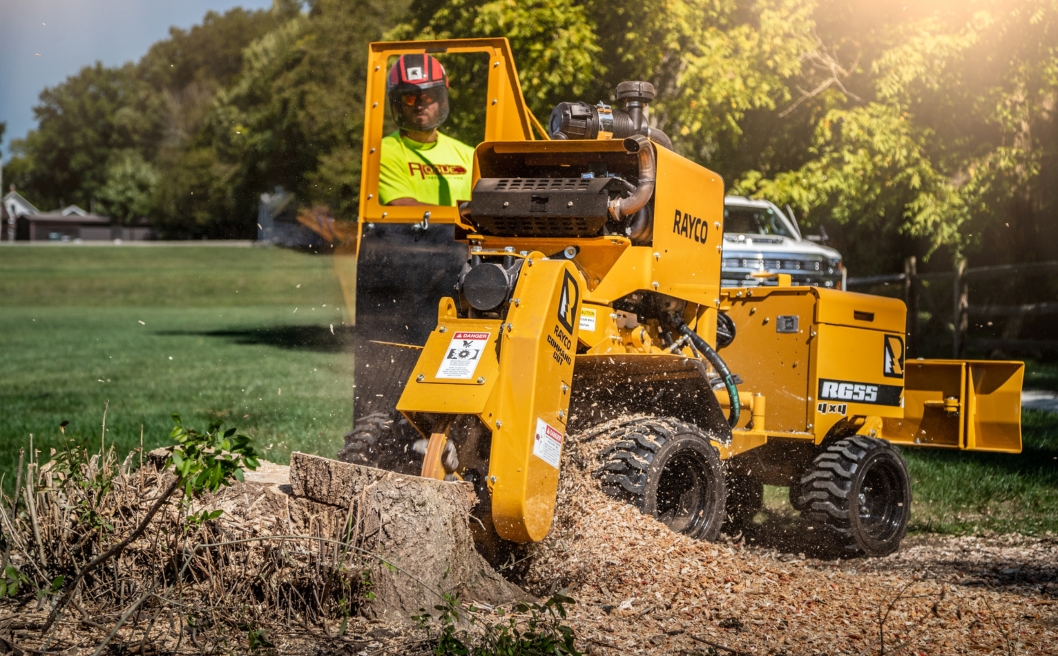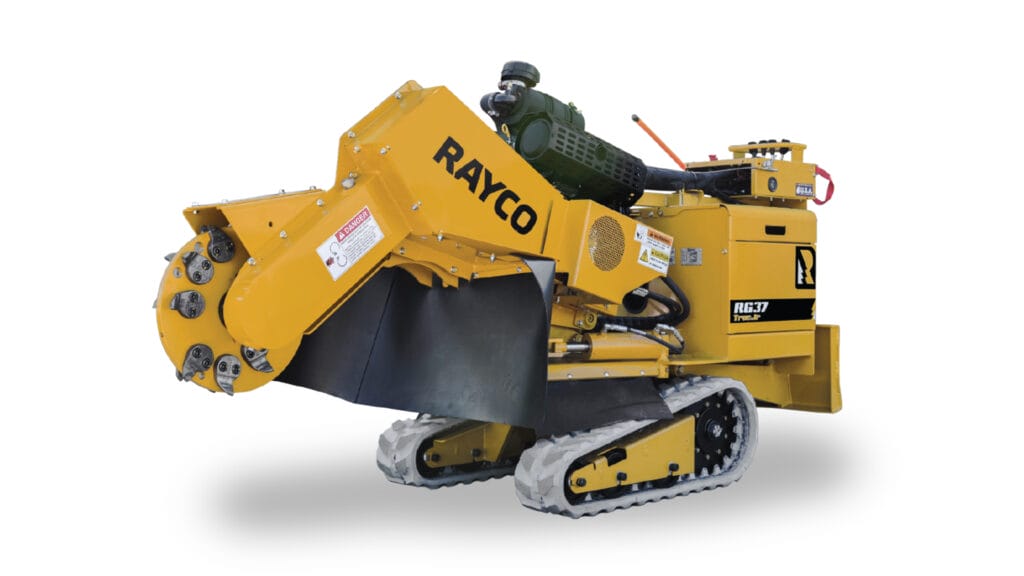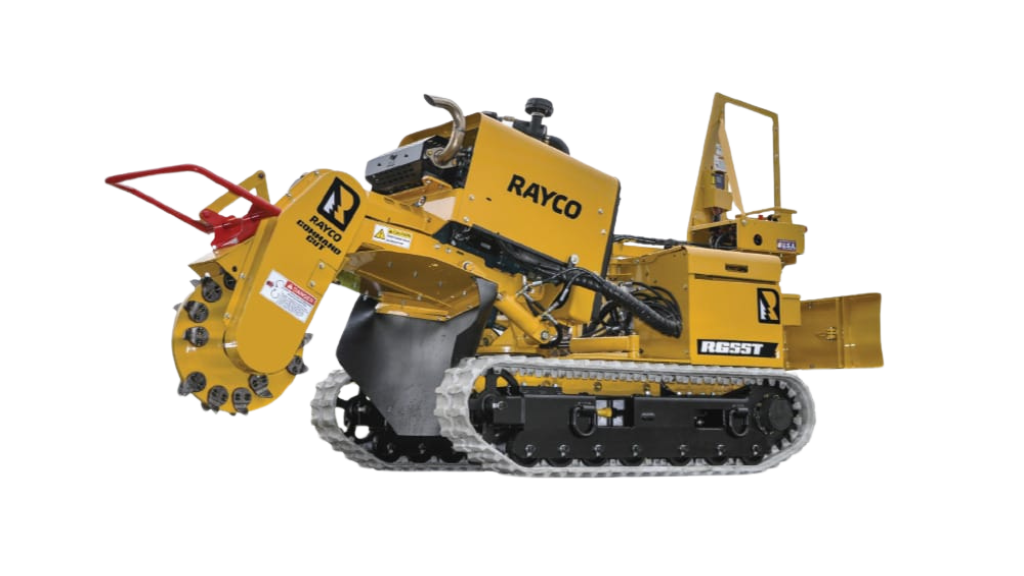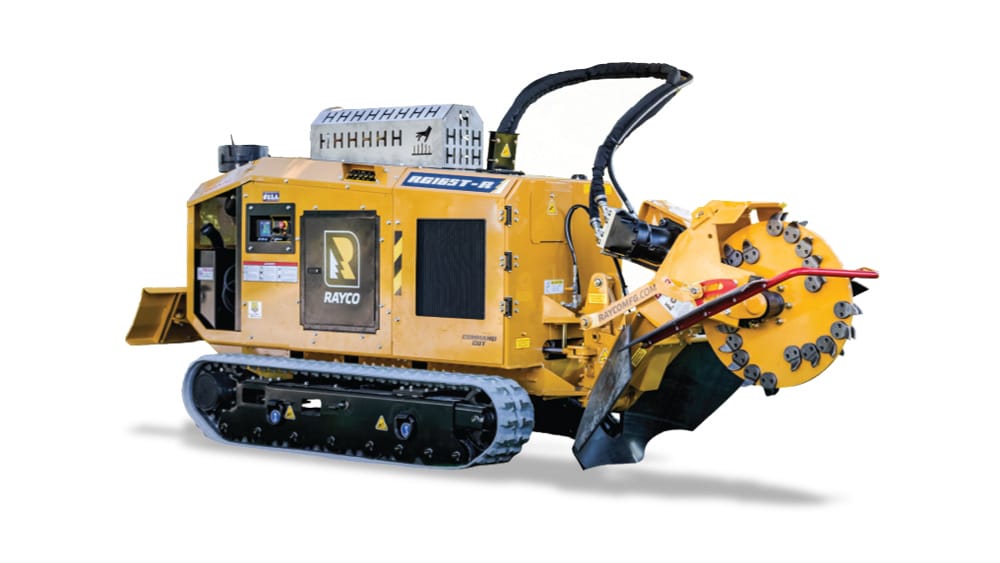
Stump Grinding: Types of Stumps That Are Too Hard to Grind

Stump grinding is a crucial part of land clearing, tree removal, and site preparation. But let’s face it—some stumps are downright nasty. Between pine stumps, dense hardwoods, deep roots, and tricky terrain, certain stump jobs can test the limits of your crew and your equipment.
So, are there stumps that are simply too hard to grind?
Not if you’ve got the right machine for the job.
In this article, we’ll explore the types of stumps that give operators the most trouble when stump grinding—and how selecting the right Rayco stump grinder can make even the toughest removals straightforward and profitable.
The Toughest Types of Stumps when Stump Grinding
1. Pine Stumps
Pine stumps are difficult to grind because their fibrous roots and sticky sap can clog cutting teeth and slow down performance. Despite being a softwood, they often have wide root spreads and resin-heavy cores that make stump grinding messy and time-consuming. A grinder with a backfill blade will be helpful for clearing the stringy mulch pine stumps produce.
TIPS:
- Keep teeth sharp and clean – pine sap builds up fast, so check teeth regularly during the job.
- Start wide and shallow – tackle the surface roots first before working into the core.
- Let the grinder work – don’t force it; slower, steady passes prevent clogging and overheating.
- Use a backfill blade – helpful for clearing the stringy mulch pine stumps often produce.
- Grind in cooler conditions if possible – heat makes the sap stickier and harder to manage.
2. Hardwood Species (Ironbark, Jarrah, Red Gum)
Australian hardwoods pose challenges when stump grinding. Trees like Ironbark and Red Gum are incredibly dense, which can quickly dull cutting teeth, increase wear on your grinder, and demand a serious amount of torque to break down.
TIPS:
- Use a high-horsepower grinder – dense hardwoods need serious torque to avoid stalling.
- Check and replace teeth frequently – hardwoods dull cutting edges fast.
- Take shallow, repeated passes – avoid deep cuts that strain the machine and reduce control.
- Watch for sparks – dry hardwoods can heat up quickly and pose a fire risk in hot conditions.
- Allow extra time – dense timber grinds slower; plan jobs accordingly to avoid rushing.
3. Large Diameter Stumps
Big, old stumps can measure well over a metre across, with root systems that run deep into the ground. Without a grinder that offers solid cutting depth and coverage, you’ll be stuck chipping away for hours—or worse, unable to finish the job at all.
TIPS:
- Start from the outside in – work in circular passes, gradually moving toward the centre.
- Grind in layers – remove one level at a time instead of going deep in one spot.
- Clear mulch as you go – keeps visibility high and prevents regrinding debris.
- Use a machine with a wide swing arc – like the RG74T-R or RG165T-R for better efficiency.
- Expect longer grind times – pace the job to avoid overheating or rushing the finish.
4. Heavily Rooted Systems (Figs, Eucalyptus)
Some species don’t just leave a central stump. Instead, they leave behind a massive network of lateral roots that can span several metres. These jobs need a grinder that can handle wide sweeps and ground-level tracking for maximum efficiency.
TIPS:
- Tackle surface roots first – clear lateral roots before focusing on the main stump.
- Follow the root lines outward – some roots may extend several metres from the base.
- Use a grinder with good tracking and reach – mobility and sweep range are key for covering ground.
- Be patient and methodical – fibrous roots can take time and dull teeth quickly.
- Consider multiple passes over the area – to fully break down spread-out root systems.
5. Stump Grinding in Rocky or Compacted Soil
Stumps growing in rocky, clay-heavy, or compacted ground are notorious for damaging cutting systems. Stones and debris can chip teeth, dull blades, and cause unnecessary strain on underpowered machines.
TIPS:
- Inspect the area first – remove visible rocks and debris to protect the cutting wheel.
- Use carbide-tipped teeth – they handle contact with hard materials better than standard teeth.
- Grind slowly and steadily – reduce impact force to avoid damaging components.
- Keep extra teeth on hand – rocky jobs often lead to chipped or dulled cutters.
- Watch for vibration – excessive shaking can signal contact with rocks beneath the surface.
6. Inaccessible or Uneven Terrain
Sometimes the stump isn’t the biggest problem—it’s how you get to it. Sloped blocks, soft soil, or tight backyards demand machines with a stable footprint, remote controls, or a tracked undercarriage to work safely and effectively.
TIPS:
- Use a tracked grinder – models like the RG55T-R or RG74T-R offer better traction and stability.
- Choose remote-controlled units – stay safe and maintain visibility on steep or tricky ground.
- Plan your access route – check gate widths, slopes, and obstacles before unloading.
- Level the grinder when possible – a stable machine cuts more efficiently and safely.
- Work slowly and maintain footing – safety comes first when the ground is unpredictable.
To make sure you and your team are operating your stump grinder safely, check out Safe Work Australia’s Guide to Managing Risks of Tree Trimming and Removal Work – with particular focus on page 21 on stump grinding.
The Right Stump Grinder for the Job: Our Recommended Models
If you’re regularly facing difficult stump grinding jobs, upgrading your gear can make all the difference. At Monitor Lifts, we offer a range of powerful, operator-friendly stump grinders designed to handle Australia’s toughest timber, terrain, and workloads.
Here’s how our models stack up:
Rayco RG25HD – Compact, Reliable, and Built for Tight Access Stump Grinding

View the RG25HD →
Perfect for smaller hardwood stumps and narrow access situations. The RG25HD is a tough little machine built for everyday residential jobs.
Key Features:
- 25 HP Kohler petrol engine
- Narrow profile & can fit through standard 76.2cm gates
- Manual controls
- Ideal for tight sites and smaller contractors
Rayco RG37 Trac – Compact Tracked Performance

View the RG37 Trac →
The RG37 Trac is compact, stable, and highly capable on soft or sloped ground. A great choice for operators tackling challenging residential sites.
Key Features:
- 37 HP Vanguard petrol engine
- Tracked for better ground control
- Self-propelled with a low profile
- Great on soft soils or uneven terrain
Rayco RG55 – Versatile Mid-Range Stump Grinding Workhorse

View the RG55 →
The RG55 delivers serious grinding power in a narrow, wheeled chassis. It’s a flexible solution for contractors dealing with a mix of residential and commercial work.
Key Features:
- 53.4 HP Kubota petrol engine
- Easy to transport
- Narrow build for gated access
- Hydraulic backfill blade for cleanup
Rayco RG55T-R – Tracked Stability, Remote-Controlled Safety

View the RG55T-R →
The RG55T-R brings the power of the RG55 with the added benefit of remote control and a tracked undercarriage—making it ideal for more complex or higher-risk job sites.
Key Features:
- 53.4 HP Kubota petrol engine
- Full remote operation
- Rugged tracks for uneven or soft ground
- Suited for professional contractors and councils
Rayco RG74T-R – High Horsepower, Total Stump Grinding Control

View the RG74T-R →
For tough hardwoods, wide stumps, and demanding commercial workloads, the RG74T-R offers power and precision in one smart package.
Key Features:
- 74 HP Cummins diesel engine
- Fully remote-operated
- Wide rubber tracks for stability
- Built to handle stubborn roots and dense species
Rayco RG80-R – Muscle Meets Mobility

View the RG80-R →
The RG80-R is a high-output machine that still fits on urban job sites. Big power, responsive handling, and serious grinding ability.
Key Features:
- 85 HP Ford petrol engine
- Remote operation
- Ideal for mixed-use contractors
- Handles large hardwoods and challenging terrain
Rayco RG165T-R – The Ultimate Stump Grinding Experience

View the RG165T-R →
When size, power, and speed matter most, the RG165T-R is the flagship solution. Built for land clearing, municipal contracts, and high-output operations.
Key Features:
- 165 HP Ford petrol engine
- Fully remote controlled
- Wide tracks for unmatched stability
- Crushes massive, deeply rooted stumps
So… When Stump Grinding Are Some Stumps Too Hard?
In rare cases—like stumps surrounded by concrete or buried in debris—it may not be worth grinding. But for almost every real-world stump, the issue isn’t the wood—it’s having the right machine for the job.
From small backyard removals to commercial land clearing, the right grinder can turn a hard job into a profitable one.
Need Help Choosing the Right Stump Grinder?
At Monitor, we know the challenges of Australian tree work inside and out. Whether you’re a contractor, arborist, or council crew, our range of stump grinders is built to handle whatever’s in the ground.
Explore our full range here:
https://monitor.net.au/tree-care-and-forestry/stump-grinders/
Or give us a call today—we’ll help you match the perfect machine to your work.
FAQs
Do I need a stump grinder or can I dig the stump out?
Stump grinding is typically faster, cleaner, and more efficient than digging. Digging out a stump often causes more damage to the surrounding area and requires heavy equipment or manual labour.
How deep can a stump grinder grind?
Most commercial stump grinders can grind between 200mm and 600mm deep. Depth varies by model—larger machines like the Rayco RG165T-R can grind significantly deeper than smaller residential units.
Can I use a stump grinder on all types of wood?
Yes—but harder timbers like Ironbark or Red Gum require a more powerful machine. Make sure your grinder has the right engine size and cutting system for the timber type.
How long does it take to grind a stump?
Most stumps can be ground in 15–45 minutes, depending on size, species, and root spread. Larger or hardwood stumps can take longer.
Can I remove any tree I want in Australia?
No. Make sure you are aware of any protected species or areas in Australia, where vegetation clearing is prohibited. Take a look at the NSW RFS Vegetation Clearing Code of Practice for more information.
- Tamworth
- 143 Gunnedah Rd, West Tamworth NSW 2340
- (02) 6755 6000
- Sydney
- 49-50 Cassola Pl, Penrith NSW 2740
- (02) 8678 5537
- Melbourne
- 24-28 Williams Rd, Dandenong South VIC 3175
- (03) 9791 7178
- Brisbane - Caboolture
- 2 Alta Road, Caboolture QLD 4510
- Brisbane - Crestmead
- 191 Magnesium Dr, Crestmead QLD 4132
- Perth
- 11 Reihill Rd, Maddington WA 6109




